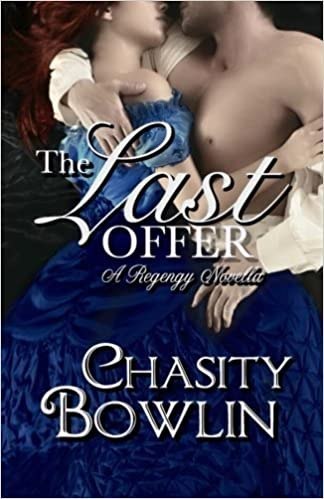The Last Offer
The Last Offer by Chasity Bowlin 2016 Regency Novella

This novella introduces us to Olivia shortly after being rescued with her brother Algernon Dunne arriving at an inn where his former best friend Lord Burke Holland has taken her after saving her from Melville, a man who kidnapped her and was going to force her to marry him for her fortune.
A year passes and Olivia is a social outcasts for no fault of her own and decides to take a lover. She chooses Burke and Algernon tells Burke about Olivia’s plans. He also confesses he never told Olivia that Burke offered for her which caused their rift in friendship.
Burke loves Olivia but knows he has to be her lover to convince her to marry him. Bowlin also shows that Melville was only working for Hurston, who is still plotting to kidnap Olivia and force her to marry him. He hires two thugs to follow her.
Bowlin describes Olivia’s deflowering in detail and readers who like instruction in lovemaking will find those passages interesting. Olivia is kidnapped by the two thugs and in true Regency plotting, Burke rescues her.
The story was well written except for some Point of View ping pong matches in the early chapters. I want to focus on expanding a novella into a full novel. Our heroine is kidnapped twice but the reader knows nothing about the details. A writer should show rather than tell. Show Olivia being abducted, her fight, her fears, and all the emotions that go with a traumatic event. Put your characters in danger to show their strengths. We only have a hint of Olivia’s gumption.
In addition, the story could have been started earlier at a ball where she longs for Burke to dance with her and to show off her popularity to contrast with the rejection later after Melville’s abduction. We’re told she was popular but show that popularity and how it affects her attitude, pride, and reaction in how others treat her. Most women can identify with being gossiped about and the range of emotions that come with the hurt, helplessness, and facing the attacker or running away. None of this is shown in a novella but can be expressed in a novel.
Burke and Algernon could have been developed more as well. In addition, the villain, Hurston, remains a mystery except for a few details. In a novel, the villain needs to be developed to contrast with the hero and heroine and to be a worthy adversary.
More book reviews can be found at http://www.authorfreeman.wordpress.com



